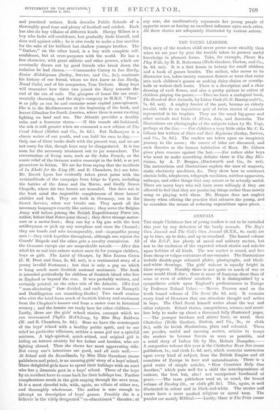THE YOUNG LEARNER.
Gun envy of the modern child never grows more steadily than when we sec year by year the trouble taken to present useful knowledge in pleasant forms. Take, for example, Plants We Play With, by H. R. Robertson (Wells Gardner, Darton, and Co., 3s. 6d. net). It is a first lesson in botany for small children and a book of games besides. The author, who seems to be illustrator too, takes twenty common flowers or trees that enter into such children's games as making daisy-chains or cowslip. balls or walnut-shell boats. There is a description and a clear drawing of each flower, and also a pretty picture in colour of children playing the games.—Then we have a zoological book, The Hundred Best Animals:by Lilian Gask (G. G. Hump and Co., 7s. 6d. not). A mighty hunter of the past, become an elderly invalid, tells to an inquisitive pair of twins stories of animals represented in his trophies. They are the usual big-game and other animals and birds of Africa, Asia, and .Australia. The illustrations are photographs of the subjects taken by Mr. Vogt, perhaps at the Zoo.—For children a very little older Mr. C. Be Gibson has written of Stars and their Mysteries (Seeley, Service, and Co., 3e, 6d.). The readers are taken upon an imaginary journey to the moon ; the causes of tides are discussed, and such theories as the human habitation of Mars. Mr. Gibson gives plain reasons against the last.—For rather older boys who want to make something definite there is The Boy Eke- trician, by A. P. Morgan (Duckworth and Co., 5s. net). The instructions and illustrations explain the uses of magnets, statist electricity machines, &c. They show how to construct electric bells, telephones, telegraph machines, wireless. apparatus, railways, and other things that may amuse or be actually useful, There are many boys who will learn more willingly if they . are allowed to feel that they are producing things rather than merely using or playing with them. Mr. Morgan does not . neglect theory when offering the practice that attracts the young, and he considers the .means of reducing expenditure upon plant.




















































 Previous page
Previous page